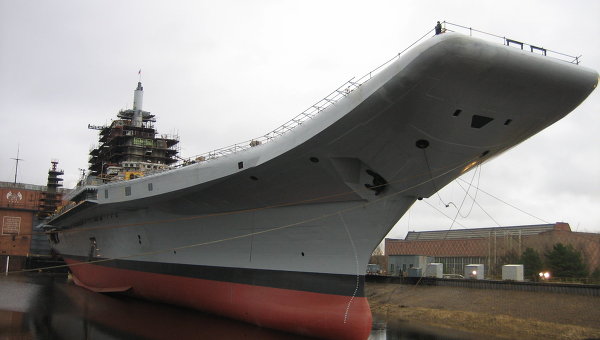
A Depressing Curtain for Russian Naval Power: Admiral Sergei Gorshkov Fails Her Sea Trials (Part Two)
Publication: Eurasia Daily Monitor Volume: 9 Issue: 224
By:

In September 2012, Russia carried out sea trials of the retired Soviet-era heavy carrier “Sergei Gorshkov,” which it is retrofitting and selling to India. The results of the sea trial of the carrier, which the Indians will rechristen the Vikramaditya, ended in embarrassing failure and severe damage to the vessel’s boiler (see EDM November, 30).
As is the Russian tradition, one of the first questions asked about the fiasco was: “Kto vinovat [Whose fault is it]?” An article in Sovetskaia Rossiia put the blame on the Russian defense establishment. It had lost the ability to carry out such large-scale projects and was in danger of losing its market in India to the United States, which had already offered India the decommissioned CV Kitty Hawk free, if India would buy Hornet F-18 E/F fighters. India had declined that offer on the basis of the schedule for the delivery of the Vikramaditya and its MiG-29 compliment. But more such failures by Russian defense contractors could mean the loss of India as a future customer.
Dmitry Rogozin, deputy prime minister for defense industry and technology, denied any problems declaring on Facebook: “The basic tests of the aircraft carrier Vikramaditya, which we are modernizing for India, went well. […] After the replacement of the heat shield for the boilers, the warship will become a mighty weapon for the Indian Navy” (Vzgliad, September 21, 23). As the controversy continued, Rogozin proclaimed that everyone else was at fault, except the Russians. He claimed problems stemmed from many sources, including technology from Poland and Great Britain that the Indians had selected. The hint of sabotage by the North Atlantic Treaty Organization (NATO) was the sub-script to this text. Yet, Rogozin’s chief villain turned out to be the Chinese who had apparently provided the fire bricks for the boilers, and these had failed.
The Russian press carried follow-up articles on the disaster and its implications. Izvestia pointed out that China, which had bought the incomplete Soviet-era aircraft carrier Variag from Ukraine, had already completed the construction of this vessel, renamed the Liaonin, and had taken it to sea. Moreover, the People’s Liberation Army Navy had announced plans to procure four more ships of this class. Consequently, China had gotten ahead of Russia in the building of carriers (Izvestiia, September 27).
The sharpest line of criticism of the Russian shipbuilding industry’s handling of the troubled carrier’s modernization came from those who knew something about warship procurement. Sergei Baimukhametov, who had previously been involved in Soviet weapons procurement, called the boiler failure during the Vikramaditya’s sea trials the symbol of an even deeper problem in the entire Russian arms industry. Baimukhametov argued that bureaucratic mechanisms for resolving frequent crises over the quality of production components no longer exist, and quality control has declined to the point where it is the main scandal of the Russian military industrial complex. Unreliable subcomponents turn billion-ruble projects into embarrassments, and around all these failures there are the scandals of corruption by officials involved in such projects (Moskovskaia Pravda, October 22).
The boiler failures on the Admiral Gorshkov are only the latest embarrassment to Russian arms producers. Other cases include the rejection of Russian fighter aircraft by Algeria in 2007, or the case of the long-delayed nuclear submarine Nerpa to be sold to India, which in November 2008 experienced a major incident at sea involving the unsanctioned operation of its fire suppression system that killed 20 and left another 21 hurt. In 2009 the vessel entered Russian naval service and in 2011 was turned over to India. The problems with the Nerpa illustrate the increasing costs and technical difficulties associated with the new Yasen-class nuclear submarines, which are taking longer to build at Sevmash’s yards and costing more. In response to these and other recent failures, Deputy Prime Minister Rogozin warned that such reduction in quality control will not be tolerated (Moskovskaia Pravda, October 22).
In late October 2012, Andrei D’iachkov, President of United Shipbuilding Corporation, reported that the repairs on the Vikramaditya would be completed by the end of October 2013 and that the ship would then be turned over to the Indian Navy (Nezavisimaya Gazeta, October 31). That date is, of course, subject to delays because of other system failures. Before glasnost, Soviet defense industries did not worry about such public scandals over system failures. The command system had its own sanctions for those involved in “wrecking.” Putin’s Russia, however, seems unable to battle corruption and ensure quality control.
On November 7, VPK published an interview with Ivan Goncharenko, first deputy director of Rosoboronexport, who specializes in foreign naval sales. Goncharenko repeated Rogozin’s opinion that the boiler failure was no big deal. But as an expert in naval technology he also emphasized the complexity of building or modernizing modern aircraft carriers. He freely acknowledged that the decline of the Russian shipbuilding industry had made the construction of modern warships more difficult and even endorsed the purchase of two French Mistral-class amphibious assault ship/helicopter carriers. The Rosoboronexport deputy director also stressed the importance of acquiring foreign technology and know-how in order to improve the quality of the domestic defense industry. A week before this article, Captain 1st Rank Andrei Zemlianov, the deputy director of the First Central Scientific Research Institute of the Navy, addressed the Russian navy’s plans for future carriers and stated that work was going forward on the development of a new carrier concept. This modern ship would be capable of performing missions under all circumstances but would not be like either the Russian Admiral Kuznetsov- or the US Nimitz-class aircraft carriers. However, turning concepts into warships demands scientific advances and the integration of complex systems. And that Russia still has not achieved.




